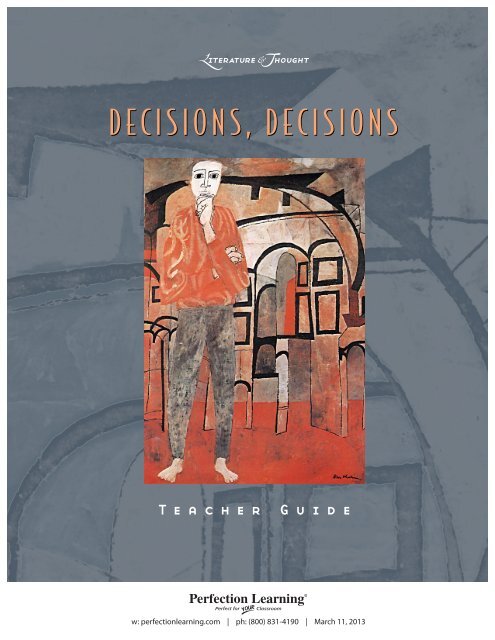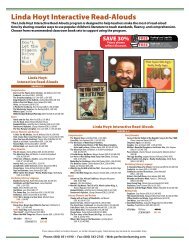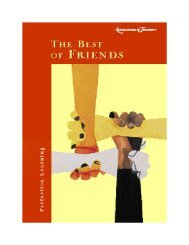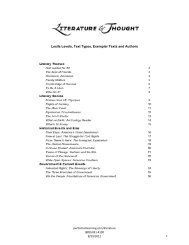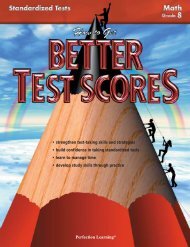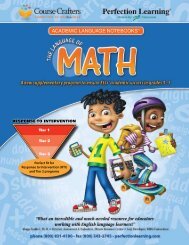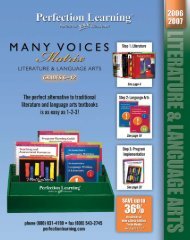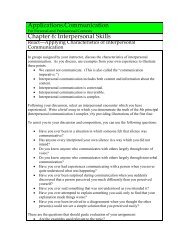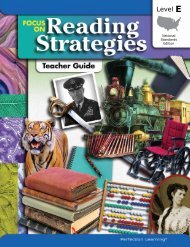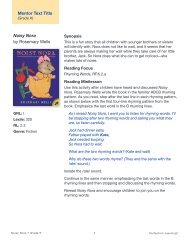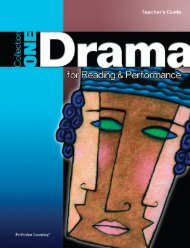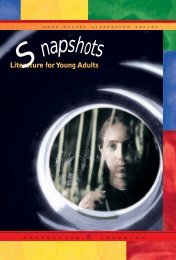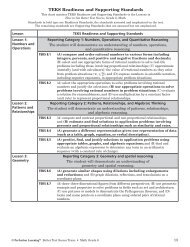Decisions, Decisions - Perfection Learning
Decisions, Decisions - Perfection Learning
Decisions, Decisions - Perfection Learning
You also want an ePaper? Increase the reach of your titles
YUMPU automatically turns print PDFs into web optimized ePapers that Google loves.
<strong>Decisions</strong>, <strong>Decisions</strong><br />
Teacher Guide<br />
<strong>Perfection</strong> <strong>Learning</strong> ®<br />
w: perfectionlearning.com | ph: (800) 831-4190 | March 11, 2013
Literature & Thought<br />
<strong>Decisions</strong>, <strong>Decisions</strong><br />
English Language Arts Standards » Reading: Literature »<br />
Grade 7 (RL)<br />
Key Ideas and Details<br />
1. Cite several pieces of textual evidence to support analysis of<br />
what the text says explicitly as well as inferences drawn from<br />
the text.<br />
2. Determine a theme or central idea of a text and analyze its<br />
development over the course of the text; provide an<br />
objective summary of the text.<br />
3. Analyze how particular elements of a story or drama interact<br />
(e.g., how setting shapes the characters or plot).<br />
Craft and Structure<br />
4. Determine the meaning of words and phrases as they are<br />
used in a text, including figurative and connotative<br />
meanings; analyze the impact of rhymes and other<br />
repetitions of sounds (e.g., alliteration) on a specific verse or<br />
stanza of a poem or section of a story or drama.<br />
5. Analyze how a drama’s or poem’s form or structure (e.g.,<br />
soliloquy, sonnet) contributes to its meaning.<br />
6. Analyze how an author develops and contrasts the points of<br />
view of different characters or narrators in a text.<br />
SB: p. 50<br />
TG: pp. 15–16, 18, 19, 20, 22, 23, 24–25, 27–28,<br />
30, 31, 32, 34, 38–39, 41, 52, 53, 54, 58, 63<br />
IWL: 1.1, 1.2, 1.3, 1.4, 2.1, 2.2, 3.1, 3.2<br />
SB: pp. 50, 112<br />
TG: pp. 15–16, 19, 22, 24–25, 27–28, 31, 34, 42,<br />
45–46, 52, 55, 57, 58<br />
IWL: 1.3, 1.4, 3.3, 3.4<br />
TG: pp. 15–16, 20, 22, 27–28<br />
IWL: 1.1, 1.2<br />
SB: p. 12<br />
TG: pp. 17, 18, 19, 23, 26, 29, 32, 33, 34, 37, 40, 41,<br />
42, 44, 47, 51, 53, 55, 59<br />
TG: pp. 22, 53<br />
TG: pp. 18, 44, 52<br />
Integration of Knowledge and Ideas<br />
7. Compare and contrast a written story, drama, or poem to its<br />
audio, filmed, staged, or multimedia version, analyzing the<br />
effects of techniques unique to each medium (e.g., lighting,<br />
sound, color, or camera focus and angles in a film).<br />
8. (Not applicable to literature) (Not applicable to literature)<br />
9. Compare and contrast a fictional portrayal of a time, place,<br />
or character and a historical account of the same period as a<br />
means of understanding how authors of fiction use or alter<br />
history.<br />
TG: p. 54<br />
Range of Reading and Level of Text Complexity<br />
10. By the end of the year, read and comprehend literature,<br />
including stories, dramas, and poems, in the grades 6–8 text<br />
complexity band proficiently, with scaffolding as needed at<br />
the high end of the range.<br />
SB: The anthology includes texts of varying levels of<br />
complexity.<br />
TG: Suggestions for additional readings on pages<br />
68–69 include selections that are challenging,<br />
average, and easy.<br />
Return to Correlation Links<br />
80<br />
L i t e r a t u r e a n d t h o u g h tw: perfectionlearning.com | ph: (800) 831-4190 | March 11, 2013 <strong>Decisions</strong>, <strong>Decisions</strong>
Literature & Thought<br />
<strong>Decisions</strong>, <strong>Decisions</strong><br />
English Language Arts Standards » Reading: Informational Text »<br />
Grade 7 (RI)<br />
Key Ideas and Details<br />
1. Cite several pieces of textual evidence to support analysis of<br />
what the text says explicitly as well as inferences drawn from<br />
the text.<br />
2. Determine two or more central ideas in a text and analyze<br />
their development over the course of the text; provide an<br />
objective summary of the text.<br />
3. Analyze the interactions between individuals, events, and<br />
ideas in a text (e.g., how ideas influence individuals or<br />
events, or how individuals influence ideas or events).<br />
Craft and Structure<br />
4. Determine the meaning of words and phrases as they are<br />
used in a text, including figurative, connotative, and<br />
technical meanings; analyze the impact of a specific word<br />
choice on meaning and tone.<br />
5. Analyze the structure an author uses to organize a text,<br />
including how the major sections contribute to the whole<br />
and to the development of the ideas.<br />
6. Determine an author’s point of view or purpose in a text and<br />
analyze how the author distinguishes his or her position from<br />
that of others.<br />
SB: p. 50<br />
TG: pp. 15–16, 21, 24–25, 27–28, 38–39, 43, 52, 63<br />
IWL: 1.1, 1.2, 1.3, 1.4, 2.1, 2.2, 3.1, 3.2<br />
SB: p. 50<br />
TG: pp. 21, 24–25, 52, 56<br />
IWL: 1.3, 1.4<br />
TG: pp. 15–16<br />
IWL: 1.1, 1.2<br />
Integration of Knowledge and Ideas<br />
7. Compare and contrast a text to an audio, video, or<br />
multimedia version of the text, analyzing each medium’s<br />
portrayal of the subject (e.g., how the delivery of a speech<br />
affects the impact of the words).<br />
8. Trace and evaluate the argument and specific claims in a<br />
text, assessing whether the reasoning is sound and the<br />
evidence is relevant and sufficient to support the claims.<br />
9. Analyze how two or more authors writing about the same<br />
topic shape their presentations of key information by<br />
emphasizing different evidence or advancing different<br />
interpretations of facts.<br />
SB: p. 12<br />
TG: pp. 17, 26, 29, 37, 40, 47, 51, 56, 59<br />
TG: pp. 49–50, 52<br />
IWL: 4.1, 4.2<br />
SB: p. 86<br />
TG: pp. 35–36, 43<br />
IWL: 2.1, 2.2, 2.3, 2.4<br />
TG: pp. 60, 63<br />
Range of Reading and Level of Text Complexity<br />
10. By the end of the year, read and comprehend literary<br />
nonfiction in the grades 6–8 text complexity band<br />
proficiently, with scaffolding as needed at the high end of<br />
the range.<br />
SB: The anthology includes texts of varying levels of<br />
complexity.<br />
TG: Suggestions for additional readings on pages<br />
68–69 include selections that are challenging,<br />
average, and easy.<br />
Return to Correlation Links<br />
<strong>Decisions</strong>, <strong>Decisions</strong>w: perfectionlearning.com | ph: (800) 831-4190 | March 11, 2013 L i t e r a t u r e a n d t h o u g h t<br />
81
Literature & Thought<br />
<strong>Decisions</strong>, <strong>Decisions</strong><br />
English Language Arts Standards » Writing » Grade 7 (W)<br />
Text Types and Purposes<br />
1. Write arguments to support claims with clear reasons and<br />
relevant evidence.<br />
a. Introduce claim(s), acknowledge alternate or opposing<br />
claims, and organize the reasons and evidence logically.<br />
b. Support claim(s) with logical reasoning and relevant<br />
evidence, using accurate, credible sources and<br />
demonstrating an understanding of the topic or text.<br />
c. Use words, phrases, and clauses to create cohesion and<br />
clarify the relationships among claim(s), reasons, and<br />
evidence.<br />
d. Establish and maintain a formal style.<br />
e. Provide a concluding statement or section that follows<br />
from and supports the argument presented.<br />
2. Write informative/explanatory texts to examine a topic and<br />
convey ideas, concepts, and information through the<br />
selection, organization, and analysis of relevant content.<br />
a. Introduce a topic clearly, previewing what is to follow;<br />
organize ideas, concepts, and information, using strategies<br />
such as definition, classification, comparison/contrast, and<br />
cause/effect; include formatting (e.g., headings), graphics<br />
(e.g., charts, tables), and multimedia when useful to<br />
aiding comprehension.<br />
b. Develop the topic with relevant facts, definitions, concrete<br />
details, quotations, or other information and examples.<br />
c. Use appropriate transitions to create cohesion and clarify<br />
the relationships among ideas and concepts.<br />
d. Use precise language and domain-specific vocabulary to<br />
inform about or explain the topic.<br />
e. Establish and maintain a formal style.<br />
f. Provide a concluding statement or section that follows<br />
from and supports the information or explanation<br />
presented.<br />
3. Write narratives to develop real or imagined experiences or<br />
events using effective technique, relevant descriptive details,<br />
and well-structured event sequences.<br />
a. Engage and orient the reader by establishing a context<br />
and point of view and introducing a narrator and/or<br />
characters; organize an event sequence that unfolds<br />
naturally and logically.<br />
b. Use narrative techniques, such as dialogue, pacing, and<br />
description, to develop experiences, events, and/or<br />
characters.<br />
c. Use a variety of transition words, phrases, and clauses to<br />
convey sequence and signal shifts from one time frame or<br />
setting to another.<br />
d. Use precise words and phrases, relevant descriptive<br />
details, and sensory language to capture the action and<br />
convey experiences and events.<br />
e. Provide a conclusion that follows from and reflects on the<br />
narrated experiences or events.<br />
TG: pp. 61–62<br />
SB: pp. 50, 86<br />
TG: pp. 24–25, 35–36, 60, 61–62, 64<br />
IWL: 1.3, 1.4, 2.3, 2.4<br />
SB: p. 112<br />
TG: pp. 20, 45–46, 49–50, 60, 61–62<br />
IWL: 3.3, 3.4, 4.1, 4.2<br />
Return to Correlation Links<br />
82<br />
L i t e r a t u r e a n d t h o u g h tw: perfectionlearning.com | ph: (800) 831-4190 | March 11, 2013 <strong>Decisions</strong>, <strong>Decisions</strong>
Literature & Thought<br />
<strong>Decisions</strong>, <strong>Decisions</strong><br />
English Language Arts Standards » Writing » Grade 7 (W)<br />
Production and Distribution of Writing<br />
4. Produce clear and coherent writing in which the<br />
development, organization, and style are appropriate to task,<br />
purpose, and audience. (Grade-specific expectations for<br />
writing types are defined in standards 1–3 above.)<br />
5. With some guidance and support from peers and adults,<br />
develop and strengthen writing as needed by planning,<br />
revising, editing, rewriting, or trying a new approach,<br />
focusing on how well purpose and audience have been<br />
addressed.<br />
6. Use technology, including the Internet, to produce and<br />
publish writing and link to and cite sources as well as to<br />
interact and collaborate with others, including linking to and<br />
citing sources.<br />
SB: pp. 50, 86<br />
TG: pp. 24–25, 35–36, 60, 61–62, 64, 65–67<br />
IWL: 1.3, 1.4, 2.3, 2.4<br />
TG: pp. 61–62, 65–67<br />
TG: pp. 61–62<br />
Research to Build and Present Knowledge<br />
7. Conduct short research projects to answer a question,<br />
drawing on several sources and generating additional<br />
related, focused questions for further research and<br />
investigation.<br />
8. Gather relevant information from multiple print and digital<br />
sources, using search terms effectively; assess the credibility<br />
and accuracy of each source; and quote or paraphrase the<br />
data and conclusions of others while avoiding plagiarism and<br />
following a standard format for citation.<br />
9. Draw evidence from literary or informational texts to support<br />
analysis, reflection, and research.<br />
Range of Writing<br />
10. Write routinely over extended time frames (time for<br />
research, reflection, and revision) and shorter time frames (a<br />
single sitting or a day or two) for a range of disciplinespecific<br />
tasks, purposes, and audiences.<br />
SB: pp. 50, 86<br />
TG: pp. 24–25, 35–36, 60, 61–62<br />
IWL: 1.3, 1.4, 2.3, 2.4<br />
TG: pp. 60, 61–62, 64<br />
TG: pp. 49–50, 60, 61–62, 64<br />
IWL: 4.1, 4.2<br />
TG: pp. 60, 61–62, 64<br />
Return to Correlation Links<br />
<strong>Decisions</strong>, <strong>Decisions</strong>w: perfectionlearning.com | ph: (800) 831-4190 | March 11, 2013 L i t e r a t u r e a n d t h o u g h t<br />
83
Literature & Thought<br />
<strong>Decisions</strong>, <strong>Decisions</strong><br />
English Language Arts Standards » Speaking and Listening »<br />
Grade 7 (SL)<br />
Comprehension and Collaboration<br />
1. Engage effectively in a range of collaborative discussions<br />
(one-on-one, in groups, and teacher-led) with diverse<br />
partners on grade 7 topics, texts, and issues, building on<br />
others’ ideas and expressing their own clearly.<br />
a. Come to discussions prepared, having read or researched<br />
material under study; explicitly draw on that preparation<br />
by referring to evidence on the topic, text, or issue to<br />
probe and reflect on ideas under discussion.<br />
b. Follow rules for collegial discussions, track progress<br />
toward specific goals and deadlines, and define individual<br />
roles as needed.<br />
c. Pose questions that elicit elaboration and respond to<br />
others’ questions and comments with relevant<br />
observations and ideas that bring the discussion back on<br />
topic as needed.<br />
d. Acknowledge new information expressed by others and,<br />
when warranted, modify their own views.<br />
2. Analyze the main ideas and supporting details presented in<br />
diverse media and formats (e.g., visually, quantitatively,<br />
orally) and explain how the ideas clarify a topic, text, or issue<br />
under study.<br />
3. Delineate a speaker’s argument and specific claims,<br />
evaluating the soundness of the reasoning and the relevance<br />
and sufficiency of the evidence.<br />
TG: pp. 18, 20, 22, 23, 30, 33, 34, 42, 43, 56, 58, 60,<br />
61–62, 63<br />
TG: pp. 61–62, 63<br />
TG: pp. 61–62<br />
Presentation of Knowledge and Ideas<br />
4. Present claims and findings, emphasizing salient points in a<br />
focused, coherent manner with pertinent descriptions, facts,<br />
details, and examples; use appropriate eye contact, adequate<br />
volume, and clear pronunciation.<br />
5. Include multimedia components and visual displays in<br />
presentations to clarify claims and findings and emphasize<br />
salient points.<br />
6. Adapt speech to a variety of contexts and tasks,<br />
demonstrating command of formal English when indicated<br />
or appropriate.<br />
TG: pp. 18, 60, 61–62, 63<br />
TG: pp. 61–62<br />
TG: pp. 61–62, 63<br />
Return to Correlation Links<br />
84<br />
L i t e r a t u r e a n d t h o u g h t<br />
<strong>Decisions</strong>, <strong>Decisions</strong><br />
w: perfectionlearning.com | ph: (800) 831-4190 | March 11, 2013
Literature & Thought<br />
<strong>Decisions</strong>, <strong>Decisions</strong><br />
All Standards Correlated by Selection >> Grade 7<br />
Content Pages RL<br />
ELA Reading<br />
Literature<br />
RI<br />
ELA Reading<br />
Informational<br />
Text<br />
W<br />
ELA Writing<br />
SL<br />
ELA Speaking<br />
and Listening<br />
Concept Vocabulary SB: p. 12 RL.7.4 RI.7.4<br />
Teaching the Critical<br />
Thinking Skill: Analyzing<br />
TG: pp. 15–16<br />
IWL: 1.1, 1.2<br />
Cluster One: What Influences a Decision?<br />
RL.7.1<br />
RL.7.2<br />
RL.7.3<br />
RI.7.1<br />
RI.7.3<br />
Cluster One Vocabulary TG: p. 17 RL.7.4 RI.7.4<br />
Playing God,<br />
Ouida Sebestyen<br />
Dusting,<br />
Julia Alvarez<br />
CCSS Exemplar Author<br />
TG: p. 18<br />
TG: p. 19<br />
RL.7.1<br />
RL.7.4<br />
RL.7.6<br />
RL.7.1<br />
RL.7.2<br />
RL.7.4<br />
TLA, Jane McFann TG: p. 20 RL.7.1<br />
RL.7.3<br />
“I would have<br />
preferred to carry<br />
through,”<br />
Richard M. Nixon<br />
Waiting for the<br />
Barbarians,<br />
Constantin Cavafy<br />
The One Who Watches,<br />
Judith Ortíz Cofer<br />
CCSS Exemplar Author<br />
Responding to<br />
Cluster One<br />
Writing Activity: Analyzing<br />
the Decision-Making<br />
Process<br />
Cluster One<br />
Vocabulary Test<br />
Teaching the Critical<br />
Thinking Skill:<br />
Evaluating<br />
TG: p. 21<br />
TG: p. 22<br />
TG: p. 23<br />
SB: p. 50<br />
TG: pp. 24–25<br />
IWL: 1.3, 1.4<br />
RL.7.1<br />
RL.7.2<br />
RL.7.3<br />
RL.7.5<br />
RL.7.1<br />
RL.7.4<br />
RL.7.1<br />
RL.7.2<br />
RI.7.1<br />
RI.7.2<br />
RI.7.1<br />
RI.7.2<br />
TG: p. 26 RL.7.4 RI.7.4<br />
TG: pp. 27–28<br />
IWL: 2.1, 2.2<br />
W.7.3<br />
W.7.2<br />
W.7.4<br />
W.7.7<br />
Cluster Two: Good Decision or Bad Decision?<br />
RL.7.1<br />
RL.7.2<br />
RL.7.3<br />
RI.7.1<br />
Cluster Two Vocabulary TG: p. 29 RL.7.4 RI.7.4<br />
A Kind of Murder,<br />
Hugh Pentecost<br />
Trapped in the Desert,<br />
Gary Beeman<br />
Traveling Through the<br />
Dark, William Stafford<br />
SL.7.1<br />
SL.7.4<br />
SL.7.1<br />
SL.7.1<br />
SL.7.1<br />
TG: p. 30 RL.7.1 SL.7.1<br />
TG: p. 31<br />
TG: p. 32<br />
RL.7.1<br />
RL.7.2<br />
RL.7.1<br />
RL.7.4<br />
Return to Correlation Links<br />
<strong>Decisions</strong>, <strong>Decisions</strong><br />
L i t e r a t u r e a n d t h o u g h t<br />
w: perfectionlearning.com | ph: (800) 831-4190 | March 11, 2013<br />
85
Literature & Thought<br />
<strong>Decisions</strong>, <strong>Decisions</strong><br />
All Standards Correlated by Selection >> Grade 7<br />
Content Pages RL<br />
ELA Reading<br />
Literature<br />
RI<br />
ELA Reading<br />
Informational<br />
Text<br />
W<br />
ELA Writing<br />
SL<br />
ELA Speaking<br />
and Listening<br />
Long Walk to Forever,<br />
Kurt Vonnegut, Jr.<br />
Facing Donegall Square,<br />
Maria Testa<br />
Responding to<br />
Cluster Two<br />
Writing Activity: A How-To<br />
Article: Making Good<br />
<strong>Decisions</strong><br />
Cluster Two<br />
Vocabulary Test<br />
Teaching the Critical<br />
Thinking Skill: Predicting<br />
Cluster Three<br />
Vocabulary<br />
Ashes,<br />
Susan Beth Pfeffer<br />
Certain Choices,<br />
Richard Shelton<br />
Moving into the<br />
Mainstream,<br />
Slade Anderson<br />
Button, Button,<br />
Richard Matheson<br />
Responding to<br />
Cluster Three<br />
Writing Activity: The Rest<br />
of the Story<br />
Cluster Three<br />
Vocabulary Test<br />
Teaching the Critical<br />
Thinking Skill:<br />
Synthesizing<br />
TG: p. 33 RL.7.4 SL.7.1<br />
TG: p. 34<br />
SB: p. 86<br />
TG: pp. 35–36<br />
IWL: 2.3, 2.4<br />
RL.7.1<br />
RL.7.2<br />
RL.7.4<br />
RI.7.8<br />
TG: p. 37 RL.7.4 RI.7.4<br />
W.7.2<br />
W.7.4<br />
W.7.7<br />
Cluster Three: What are the Possible Consequences of Our <strong>Decisions</strong>?<br />
TG: pp. 38–39<br />
IWL: 3.1, 3.2<br />
RL.7.1<br />
RI.7.1<br />
TG: p. 40 RL.7.4 RI.7.4<br />
TG: p. 41<br />
TG: p. 42<br />
TG: p. 43<br />
TG: p. 44<br />
SB: p. 112<br />
TG: pp. 45–46<br />
IWL: 3.3, 3.4<br />
RL.7.1<br />
RL.7.4<br />
RL.7.2<br />
RL.7.4<br />
RL.7.4<br />
RL.7.6<br />
RL.7.2<br />
RI.7.1<br />
RI.7.8<br />
TG: p. 47 RL.7.4 RI.7.4<br />
TG: pp. 49–50<br />
IWL: 4.1, 4.2<br />
Cluster Four: Thinking on Your Own<br />
RI.7.7<br />
Cluster Four Vocabulary TG: p. 51 RL.7.4 RI.7.4<br />
The Price of Life,<br />
Pamela Grim<br />
i’ll never,<br />
Todd Moore<br />
TG: p. 52<br />
TG: p. 53<br />
RL.7.1<br />
RL.7.2<br />
RL.7.6<br />
RL.7.1<br />
RL.7.4<br />
RL.7.5<br />
RI.7.1<br />
RI.7.2<br />
RI.7.7<br />
W.7.3<br />
W.7.3<br />
W.7.9<br />
SL.7.1<br />
SL.7.1<br />
SL.7.1<br />
Return to Correlation Links<br />
86<br />
L i t e r a t u r e a n d t h o u g h t<br />
<strong>Decisions</strong>, <strong>Decisions</strong><br />
w: perfectionlearning.com | ph: (800) 831-4190 | March 11, 2013
Literature & Thought<br />
<strong>Decisions</strong>, <strong>Decisions</strong><br />
All Standards Correlated by Selection >> Grade 7<br />
Content Pages RL<br />
ELA Reading<br />
Literature<br />
RI<br />
ELA Reading<br />
Informational<br />
Text<br />
W<br />
ELA Writing<br />
SL<br />
ELA Speaking<br />
and Listening<br />
The Front of the Bus,<br />
Rosa Parks<br />
The Order of Things,<br />
Michel Foucault<br />
Gifted,<br />
Dave Barry<br />
The Dandelion Garden:<br />
A Modern Fable for<br />
Elderly Children,<br />
Budge Wilson<br />
Obstacles (from Man’s<br />
Search for Meaning),<br />
Viktor Frankl<br />
Cluster Four<br />
Vocabulary Test<br />
Research, Writing, and<br />
Discussion Topics<br />
Assessment and<br />
Project Ideas<br />
Answering the<br />
Essential Question<br />
TG: p. 54<br />
TG: p. 55<br />
TG: p. 56<br />
TG: p. 57<br />
TG: p. 58<br />
RL.7.1<br />
RL.7.9<br />
RL.7.2<br />
RL.7.4<br />
RL.7.2<br />
RL.7.1<br />
RL.7.2<br />
RI.7.2<br />
RI.7.4<br />
TG: p. 59 RL.7.4 RI.7.4<br />
Additional Teacher Guide Resources<br />
TG: p. 60 RI.7.9 W.7.2<br />
W.7.3<br />
W.7.4<br />
W.7.7<br />
W.7.8<br />
W.7.9<br />
W.7.10<br />
TG: pp. 61–62<br />
TG: p. 63 RL.7.1 RI.7.1<br />
RI.7.9<br />
W.7.1<br />
W.7.2<br />
W.7.3<br />
W.7.4<br />
W.7.5<br />
W.7.6<br />
W.7.7<br />
W.7.8<br />
W.7.9<br />
W.7.10<br />
Essay Test TG: p. 64 W.7.2<br />
W.7.4<br />
W.7.8<br />
W.7.9<br />
W.7.10<br />
Rubrics for Project<br />
Evaluation<br />
TG: pp. 65–67<br />
Related Literature TG: pp. 68–69 RL.7.10 RI.7.10<br />
W.7.4<br />
W.7.5<br />
SL.7.1<br />
SL.7.1<br />
SL.7.1<br />
SL.7.4<br />
SL.7.1<br />
SL.7.2<br />
SL.7.3<br />
SL.7.4<br />
SL.7.5<br />
SL.7.6<br />
SL.7.1<br />
SL.7.2<br />
SL.7.4<br />
SL.7.6<br />
Return to Correlation Links<br />
<strong>Decisions</strong>, <strong>Decisions</strong><br />
L i t e r a t u r e a n d t h o u g h t<br />
w: perfectionlearning.com | ph: (800) 831-4190 | March 11, 2013<br />
87


